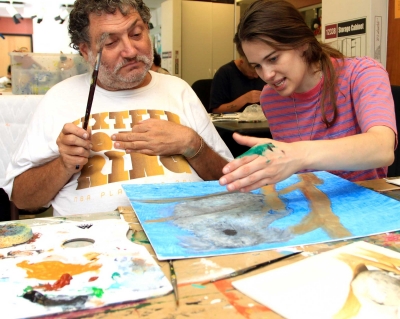In art therapy sessions, the physical act of ‘doing’ makes it a useful form of treatment for people who find “talking therapies” difficult or uncomfortable in some way. Through art therapy, a person is encouraged to express himself or herself within a safe, non-verbal environment, which in turn may have a positive effect on areas such as personal development and growth. Art therapy may also enhance the person’s relationships with others.
Art therapy seeks to achieve different results for different people, depending on their circumstances. Art therapy programs are carried out in various settings including clinics, hospitals, rehabilitation centers, prisons, educational institutes, businesses, wellness centers and in private practices. The aims of art therapy are to:
-
Encourage the expression of emotions
-
Encourage the process of creativity
-
Build self-confidence
-
Gain some control over depression, anxiety and low self-esteem
-
Help to take the mind off pain that may be felt emotionally or physically
The history of art therapy
The use of visual expression as a tool for healing may have been used for centuries, however, art therapy as it is known today only emerged as a distinct form of therapy sometime in the middle of the 20th century. There is much debate about the history of art therapy; however, it seems to have emerged as a result of psychiatric interest in the paintings and drawings of patients with mental illness, and also through educators interest in the expressive nature of children’s artwork.
Who can benefit from art therapy?
Art therapy combines the use of visual art (drawing, painting, sculpture etc.), the creative process and psychotherapy to help people manage a variety of mental, emotional and psychological problems. Art therapy can be used with children, adolescents, adults and the elderly and is a useful form of therapy for people suffering from many conditions.
Art therapy can help people that experience:
Mental or emotional problems including:
-
Depression
-
Anxiety
-
Mental illness
-
Eating disorders
-
Behavioral problems
-
Relationship problems
Health conditions
-
Physical and learning disabilities
-
Addictions
-
Chronic illness
-
Neurological conditions
-
Rehabilitation after accidents or injury
Social or trauma-related problems
-
Post traumatic stress disorder
-
Domestic violence
-
Sexual abuse therapy
-
Physical or mental abuse
-
Bereavement and grief
-
Prisoner rehabilitation
Anyone can benefit from art therapy. Expressing yourself in the form of creating a meaningful painting, sculpture or carving can offer a tremendous sense of well-being. Although the term ‘art therapy’ suggests that a person would need to have some level of artistic talent, art therapy can be used even when a person has no artistic ability whatsoever. What is most important in art therapy is the communication and expression of thoughts and feelings through the medium of art.
What happens during art therapy?
A person does not need to have any artistic experience or even artistic talent to benefit from art therapy. In the first session, a qualified art therapist - trained in both art and psychotherapy or counseling - spends some time discussing the client’s problems or health condition. The art therapist then works with the client, to create a program of art therapy that is tailored towards the client’s specific needs.
Art therapy sessions generally last for 30-60 minutes and are carried out over a period of weeks or months. Initial sessions are likely to be on a one-to-one basis with the art therapist; however, some people are referred for group art therapy sessions if it is thought that they would benefit more from group interaction.
During art therapy sessions, the client is not taught how to paint or draw, these are not technical art lessons, the therapist encourages the client to explore and express their feelings, to become more self-aware and to gain more confidence through the medium of art.

